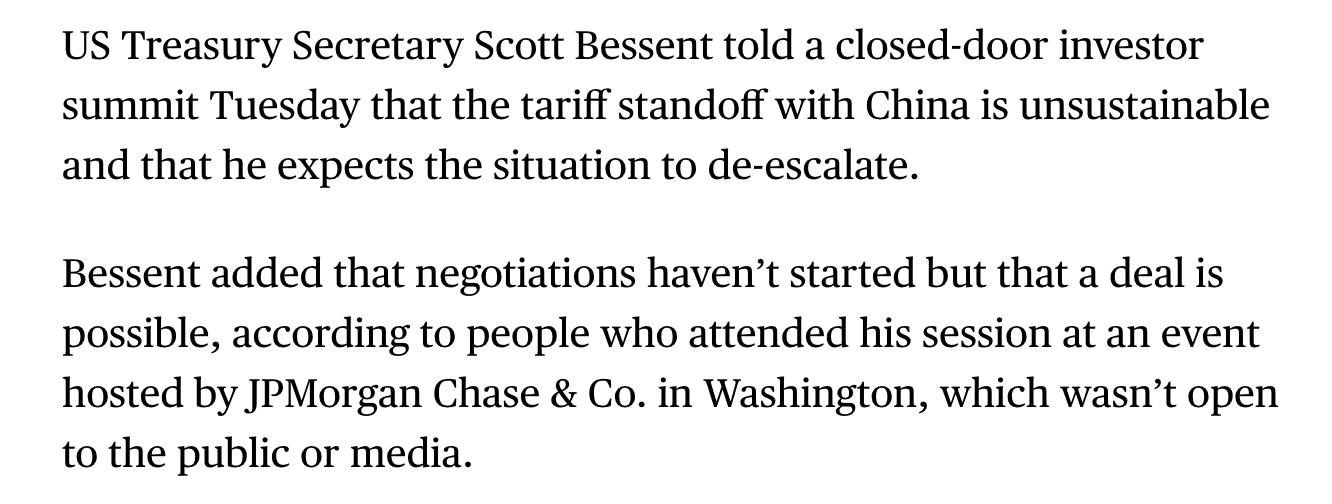As I’ve said since early March, Trump is executing what I’ve called a “controlled demolition” of the U.S. economy.
The blueprint looks like this:
Use tariffs to crash the stock market and trigger a negative wealth effect
Induce a recession or economic slowdown
Pressure Jerome Powell into cutting rates
Pivot to pro-growth policies (tax cuts, deregulation) heading into the 2026 midterms
I’ve made it abundantly clear I don’t agree with this approach. You can listen to my latest breakdown of Trump’s strategy on my podcast (Spotify and Apple Podcasts). But in investing, it doesn’t matter what I think—we have to play the cards we’re dealt.
And make no mistake, we’re deep into Step One. Earlier this month, the S&P 500 dropped -14% in just three days—one of the fastest crashes in history—and is on pace for its worst four-month start to a year ever.
Signs of a looming recession are mounting: consumer confidence is at a four-year low, global container volumes are down 30% (thanks to tariffs), manufacturing PMIs are in contraction, and jobless claims are ticking up. Goldman and JPMorgan now peg recession odds at 50%.
This is exactly the type of engineered slowdown you’d expect if the goal was to set the stage for Fed intervention. But Jerome Powell doesn’t seem eager to play along…
And for good reason. Inflation expectations are rising thanks to the “Liberation Day” tariffs. June’s month-over-month inflation is projected at 0.5%—a 6% annualized rate. Cutting rates into that would risk unanchoring inflation altogether.
That’s why I think firing Powell—as some in the administration have hinted—is a terrible idea. It would undermine Fed independence and weaken confidence in the U.S. dollar. But there’s another path the administration could take to get what it wants—rate cuts—without torching the Fed’s credibility.
And understanding that path informs the portfolio changes I'm making today.
The Rise of the "Shadow Fed Chair"
Firing Jerome Powell severely would damage global trust in the U.S. dollar.
The dollar’s reserve currency status isn’t just a function of military power or economic size—it’s rooted in the credibility of our institutions. Investors and foreign governments expect U.S. monetary policy to be independent, stable, and insulated from politics. If Powell is removed for not cutting fast enough, it makes us look less like a free-market economy and more like a centrally planned one. Markets would respond harshly—bond yields would spike, capital would flee, and the dollar’s dominance could erode faster than anyone expects.
In many ways, that process is already underway. We're seeing early signs of capital flight—U.S. bonds, stocks, and the dollar have all sold off simultaneously in recent weeks. That’s extremely rare.
But there’s a workaround the administration appears to be pursuing: let Powell finish his term—he’s out in nine months anyway—and instead install a replacement-in-waiting who can serve as a "shadow Fed chair."
Trump could nominate his preferred successor now, give them a media platform, and let them critique every Powell speech from the sidelines. This surrogate wouldn’t need to formally replace Powell to influence markets—just offer a consistent alternative narrative. Investors are forward-looking. They’ll start listening to the person they believe will soon have the real power.
Treasury Secretary Scott Bessent has already hinted at this strategy, and Federal Reserve Governor Christopher Waller—who’s been publicly calling for rate cuts—is widely viewed as the front-runner.
If Waller begins to play this role, we’ll be entering Stage 3 of the Trump administration’s "controlled demolition"—a transition from economic chaos to monetary easing.
But getting there won’t be smooth. We’re likely facing six more months of elevated volatility before the stimulus spigot opens. And that means now is the time to get our portfolio positioned—to insulate ourselves from the chop and be ready to capitalize when the tides turn.
Trump is On the Shot Clock
We've been expecting a retest of the April 8th panic lows on the S&P 500. Firing Powell, a lack of trade deals, and a weak earnings season are the quickest way for that to happen.
However, the bear case will always be most compelling on the lows. And while Trump may be erratic on the tariff rollout, he’s no fool when it comes to elections as he's won the presidency twice. With the 2026 midterms looming and primary campaigning set to ramp up by March 2026, the clock is ticking. Letting this drag into year-end risks alienating the very voters who fueled his comeback.
Bears argue Trump is dug in. I disagree. The 90-day tariff pause proved he’s watching the market—and the polls. And with recent surveys showing erosion in support, the odds of further walk-backs or “deal headlines” rise each week. We even got one this morning with Bessent saying a de-escalation with China is imminent which triggered today's monster rally:
Yes, the second half of 2025 could be soft for earnings, especially for multinationals. But with the dollar weakening, Q2 could offer a helpful foreign exchange tailwind for global names, particularly the Magnificent 7 tech stocks that had led the current bear market lower.
Inflation is also cooling—Truflation is printing just 1.44%—and the Fed has been mostly absent from the conversation. That may change soon, especially if tariffs don't spark the inflation surge many fear. And if you’re a stock picker like me, there are bargains emerging.
Most important: this isn’t 2008 or 2020. There is a shot clock. Prior bear markets dragged on because there was no easy exit ramp. This time, one man can reverse a lot of the damage with a single press conference. That man is politically incentivized to do so soon. Whether he follows through or not remains to be seen—but smart investors should be ready to pivot when the signal flashes green.
And for those who can handle some volatility, it's a good time to put a little cash to work.
Take a 297% Crypto Gain and Re-Allocate to Two Stocks
We're going to do a bit of portfolio shuffling today.








